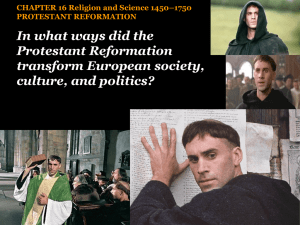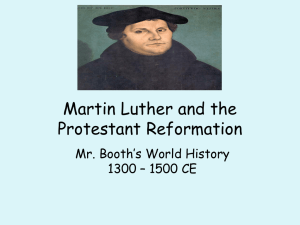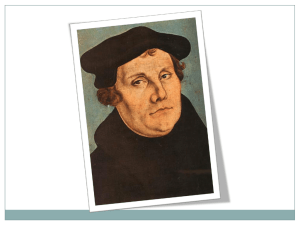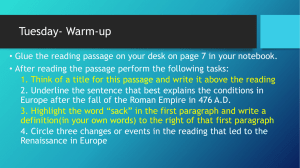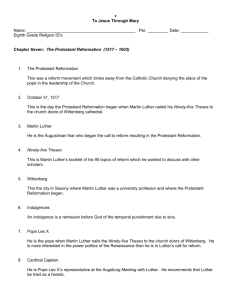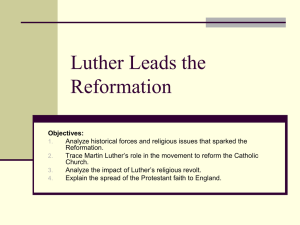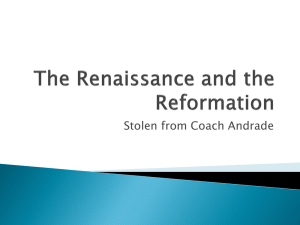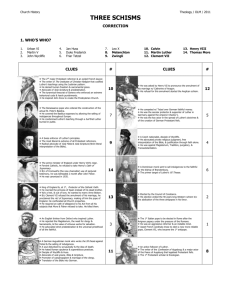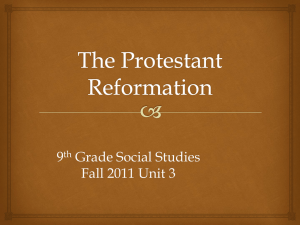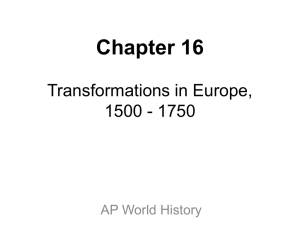reform - Mr Wyka`s Weebly
advertisement
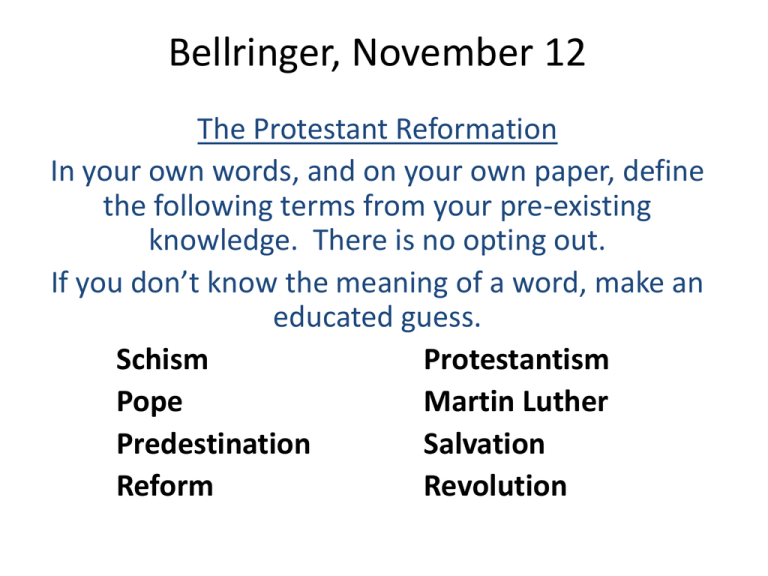
Bellringer, November 12 The Protestant Reformation In your own words, and on your own paper, define the following terms from your pre-existing knowledge. There is no opting out. If you don’t know the meaning of a word, make an educated guess. Schism Protestantism Pope Martin Luther Predestination Salvation Reform Revolution The Reformation in Europe 1517-1600 Chapter 23.1 The Spread of Protestantism Essential Questions • What conditions can encourage a desire for reform? • Is a reform different than a revolution? Martin Luther, 1529 Why does it matter? Today’s Christianity was shaped by the events of the Protestant Reformation. Christian Europe’s ability to respond to outside threats was affected by the dis-unifying effect of the Reformation. The Catholic Church reformed and codified its doctrine as a result of the Protestant Reformation. Lesson Vocabulary • • • • • • • • Schism Christian humanism Salvation Indulgence Lutheranism Fundamental External valid Lesson Vocabulary • • • • • • justification predestination annul ghetto publish community The Background • For 1000 years, Christianity had been essentially united. • In 1054, the Western and Eastern Churches split (schism). –Catholic (western), Orthodox (eastern) • In the early 1500s, several groups broke from (schism) the Catholic Church. These became the first Protestant churches. Leading to Reformation Christian Humanism paved the way for the Protestant Reformation in Europe. • Erasmus was the best known of the Christian Humanists. He wanted to reform the Church, not break from it. Need for Reform • Popes and bishops involved in politics rather than tending the spiritual needs of their people. • Emphasis on external manifestations of Faith rather than Faith itself. • Sale of indulgences. – Freedom from (all or part of) the punishment due to sin. – Does not forgive the sin itself, just remits the punishment. Martin Luther and the 95 Theses Luther was a Catholic monk. • Upset at the sale of indulgences. • In 1517, Nailed 95 Theses (challenges) to the Cathedral door of Wittenberg. –Traditional way for scholars and theologians to challenge one another. –This is considered the beginning of the Protestant Reformation. Martin Luther’s Reformation • By 1520, emboldened by his leadership position, Luther urged German princes to overthrow the pope in Germany and created a new church. • With the involvement of the princes, who lusted after valuable Church property, the movement became part political and part spiritual in motivation. The Two Fundamental Protestant Beliefs in opposition to Catholicism • Faith Alone saves. Good works merits nothing. • Sola Scriptura. Scripture alone should be a Christian’s guide. As already mentioned…. • Things got complicated when the German princes supported Martin Luther against Emperor Charles V and the pope. • Political motives and greed mixed with religious motives. • The result… WAR Religious war broke out between the German princes who supported Luther and Charles V, who supported Catholicism. Peace of Augsburg • Ended religious warfare in Germany – 1555. • Officially ended Christian unity in Europe • German rulers were free to choose between Catholicism and Lutheranism. –The people weren’t free to choose, just the rulers. Schisms within Protestantism Zwingli • Leader of Protestants in Zurich, Switzerland • Removed all religious imagery • New church service replaced the Mass. • Zwingli was killed in a battle between Catholics and Protestants. John Calvin • Leader of Protestantism in Switzerland upon the death of Zwingli • His writings spread widely due to the printing press • Preached predestination – that God had determined in advance who would be saved and who would be damned. – Undercut free will but emphasized God’s supremacy. • Created a theocracy in Geneva, Switzerland Discussion Break “The rule remains with the husband, and the wife is compelled to obey him by God’s command. He rules the home and the state, wages war, defends his possessions, tills the soil, builds, plants, etc. The woman on the other hand is like a nail driven into the wall.” - Martin Luther, from Lectures on Genesis What might Luther mean by comparing a woman to a nail in the wall? Bellringer – November 13 If we had a “pop” quiz after the tardy bell, could you answer the following questions? • Which Protestant leader is most associated with predestination? • What event politicized the Protestant Reformation in Germany? • Who was the first Protestant reformer? • What was the first Protestant church? • What treaty brought peace between Catholics and Lutherans in Germany? Reformation in England • A political reformation • The pope would not grant English King Henry VIII (the 8th) an annulment from his first wife, so he declared himself Head of the Church of England. • The Church of England is the Anglican Church. In the U.S., it is called the Episcopal Church. Henry VIII (1491 - 1547) was the King of England and besides his six marriages, Henry VIII is known for his role in the separation of the Church of England from the Roman Catholic Church. Henry VIII six wives. Catherine of Aragon was the youngest child of Ferdinand and Isabella. She was Henry VIII’s 1st wife, the mother of Mary Queen of Scots, and her divorce resulted in the separation of England from the Roman Catholic Church. Anne Boleyn was Catherine of Aragon’s Queen consort, Henry VIII’s 2nd wife, mother of Queen Elizabeth I, and was beheaded at the Tower of London for adultery. Jane Seymour married Henry VIII 10 days after Anne Boleyn’s execution, died two weeks after the birth of Edward VI, was the only wife to receive a queen’s funeral, and was buried beside Henry VIII. Anne of Cleves was Henry VIII’s 4th wife. She was German and he married her from a portrait, but when she showed up he thought she was ugly. Fearing for her life, she agreed to a divorce. Catherine Howard married Henry VII’s 20 days after his divorce from Anne of Cleves. She was Anne Boleyn’s cousin and was beheaded in less then two years for adultery. Catherine Parr was Henry VIII’s 6th and final wife. She was the first queen of Ireland and was the most married English queen - she had four husbands. Anabaptists • Unlike other protestant groups, Anabaptists separated themselves from the state and politics. • Preached a return to primitive Christianity. • Considered radical even by other Protestants. • Joint army of Catholics and Protestants captured and killed Anabaptist leaders in 1535. The Catholic Response • The Catholic Reformation revitalized the Church in the 16th century. • Three elements supported the Catholic Reformation: 1. Establishment of the Jesuits 2. Reform of the Papacy 3. The Council of Trent The Jesuits • • • • Officially called the Society of Jesus Founded by Ignatius of Loyola Obedient to the pope Used education to spread the Gospel, countered Protestantism and established schools. • Active in missionary work as far away as China and Japan Papal Reform • Instituted by a pope, Pope Paul III • Reformed the papacy and pointed it in a more spiritual direction. • Pope Paul III called a new Church council, the Council of Trent. Council of Trent • Reaffirmed traditional Catholic teaching in opposition to Protestant beliefs. • Declared both Faith and Good Works are important for salvation. (not just Faith alone) • Upheld the importance of the seven sacraments • Selling of indulgences was prohibited (something Luther wanted all along). What’s Next? • Quiz time. • Do your own work. • Use your notes.

